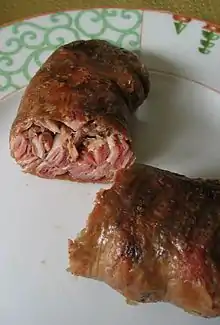Andouillette
Andouillette (French pronunciation: [ɑ̃dujɛt]) is a coarse-grained sausage made with pork (or occasionally veal), chitterlings (intestine), pepper, wine, onions, and seasonings. Tripe, which is the stomach lining of a cow, is sometimes an ingredient in the filler of an andouillette, but it is not the casing or the key to its manufacture. True andouillette will be an oblong tube. If made with the small intestine, it is a plump sausage generally about 25 mm in diameter but often it is much larger, possibly 7–10 cm in diameter, and stronger in scent when the colon is used. True andouillette is rarely seen outside France and has a strong, distinctive odour related to its intestinal origins and components. Although sometimes repellent to the uninitiated, this aspect of andouillette is prized by its devotees.
- In France, an andouille may be a large andouillette; in Cajun cooking, an andouille is a different kind of sausage.


Ingredients and history
The original composition of "andouillette sausages" is not known and there is no record of the andouillette's composition from earlier than the nineteenth century. Nineteenth century dictionaries simply describe them as "small andouilles" (petites andouilles).
During recent decades, a range of differently composed andouillettes are or have been offered by charcuterie producers: the principal differences concern the primary ingredients used, whether pork or veal or a mixture of the two. During the twenty-first century the incorporation of veal, historically the more costly meat ingredient, has been banned in response to concerns over BSE. Some French regions such as Cambrésis (the area surrounding Cambrai) and Lyonnais were still including veal right up to the ban. In other regions, pork has been the only meat in an andouillette for more than a century: that is the case with the andouillette "of Troyes", which is currently the type of andouillette most likely to be encountered in national outlets, such as supermarkets, throughout France. But it seems likely that through the nineteenth and twentieth centuries, local producers were using their own unique recipes according to time and place: the recipes used by local specialised outlets continue to vary considerably.
A number of andouillettes sold as local specialities have nevertheless evolved or indeed disappeared, such as the andouillettes of Villers-Cotterêts which received a mention in the posthumously published Culinary Dictionary (Grand Dictionnaire de cuisine) by Alexandre Dumas.
Serving
Andouillettes can be served either hot or cold, with the former much more common. As with all lower intestine sausages, andouillettes are to some extent an acquired taste. Their smell may offend people unaccustomed to the dish. The texture is somewhat rougher than most sausages, as the content is coarsely cut. Primarily pan-fried (sometimes breaded), it can also be boiled, barbecued or grilled. The sausage is often served with vegetables (primarily onions) in a mustard or red wine sauce.
Popularity
It is a common dish all over France but some regions are well known for their own recipes. The most famous ones come from Troyes, Lyon, Cambrai and Chablis and are graded using the AAAAA (5 As) grading system.[1]
Clubs
The Association Amicale des Amateurs d'Andouillette Authentique (AAAAA) 'The Friendly Club of Lovers of Authentic Andouillette' is a club formed by several food writers in 1970. It gives certificates ("diplôme") to producers of high-quality andouillettes.[2]
References
- 5 A pour l'andouillette - http://agriculture.gouv.fr/5-pour-landouillette Archived 2018-05-23 at the Wayback Machine
- "Statuts | La 5A :". aaaaa-asso.fr. Archived from the original on 2017-08-17. Retrieved 2017-08-17.
See also
External links
| Wikimedia Commons has media related to Andouillette. |
- Association amicale des amateurs d'andouillette authentique, at French Wikipedia
- http://aaaaa-asso.fr/ Website of Association Amicale des Amateurs d'Andouillette Authentique (French)
